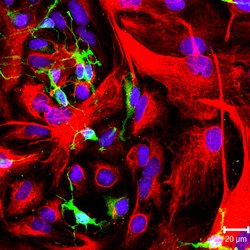Oligodendrocyte progenitor
| Oligodendrocyte progenitor cell | |
|---|---|

NG-2 positive oligodendrocyte progenitor cells (green color) and GFAP-positive astrocytes (red color) in culture.
|
|
| Details | |
| Identifiers | |
| Latin | Cellula oligodendrocytoprogenetrix |
| Code | TH H2.00.06.2.01007 |
| NeuroLex ID | Oligodendrocyte precursor cell |
|
Anatomical terminology
[]
|
|
Oligodendrocyte progenitor cells (OPCs), also known as oligodendrocyte precursor cells, NG2-glia or polydendrocytes, are a subtype of glial cells in the central nervous system. They are precursors to oligodendrocytes and may also be able to differentiate into neurons and astrocytes. Differentiated oligodendrocytes support axons and provide electrical insulation in the form of a myelin sheath, enabling faster action potential propagation and high fidelity transmission without a need for an increase in axonal diameter. The loss or lack of OPCs, and consequent lack of differentiated oligodendrocytes, is associated with a loss of myelination and subsequent impairment of neurological functions.
Oligodendrocyte progenitor cells are a subtype of glial cells in the central nervous system, characterized by expression of the proteoglycans PDGFRA, and CSPG4. OPCs are smaller than neurons, of comparable size to other glia, and can either have a bipolar or complex multipolar morphology with processes reaching up to ~50 um.
OPCs encompass approximately 3-4% of cells in the grey matter and 7-8% in white matter, making them the fourth largest group of glia after astrocytes, microglia and oligodendrocytes.
OPCs are particularly prevalent in the hippocampus and in all layers of the neocortex. In white matter, OPCs are found along unmyelinated axons as well as along myelinated axons, engulfing nodes of Ranvier. Recently, OPCs have been shown to reside in close contact with NG2-expressing pericytes in cerebral white matter, as well.
...
Wikipedia
